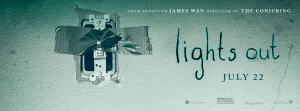
It happens in every horror film. The lights begin to flicker and soon the darkness. A ghostly apparition lurks in the shadows, waiting for the opportune time to pounce. A creepy score accompanies its stalking and once it attacks, a loud boom is let out; a boo, if you will. The victim scrambles to safety, most comfortable in the welcoming glow of the light.
Most horror films rely on this sequence once or twice. “Lights Out” builds an entire premise around it. This may seem like a limited endeavor, and the fact that this was adapted from a three-minute short seemingly justifies that, but it actually works. It hits a few snags along the way, though that’s more to do with director David F. Sandberg’s clumsiness when adhering to the rules set up in the script written by Eric Heisserer.
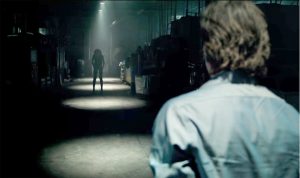
I noted in my review of “The Conjuring 2” how James Wan is more focused on building dread around the jump scare as opposed to the jump itself. Sandberg is the same way, which makes sense considering Wan is a producer on this film. Sandberg is fascinated by the common trope detailed in the opening of this review, wanting to find a way to play around with it. Instead of having it exist solely to solicit the scare, he contains the scare within it. The lights flickering is always the precursor to the scare. Here, the story is the precursor to the lights flickering.
We wait with bated breath for the lights to start acting up. A quick flicker or a lightbulb dimming sends shivers up our spines. Anytime darkness was even hinted at, the crowd I seen the film with gasped in preparation. Sandberg had us all hooked. Any time we let our guards down, he’d start messing with the lights akin to a kid freaking out their younger sibling.
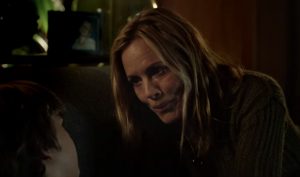
The entity, named Diana, can only attack when the lights are out. We soon learn it’s due to a rare skin condition she had as a child, with bright light burning her (no word on if getting her wet or feeding her after midnight causes any side effects). She was best friends with Sophie (Maria Bello), now a grown adult with children and a crippling depression. Diana feeds off of Sophie’s depression and guilt, residing in her home via forced entry.
This caused a rift with her daughter, Rebecca (Teresa Palmer), and is now causing one with her young son, Martin (Gabriel Bateman). It’s only gotten worse after the death of Martin’s father, Paul (Billy Burke). This causes Sophie to spiral into a depressed haze, one we the audience knows is because of Diana, but the kids don’t. Well, Rebecca had her encounters with the ghost as a child, but chalked it up to her mother’s insanity influencing her. Martin is quick to believe after catching his mother conversing with Diana, followed by being stalked by her.
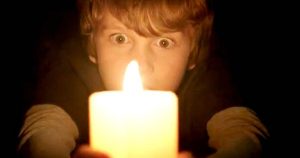
Normally, this much insight into the ghost’s backstory is a problem. A monster is made scarier when its intentions are barely known. The air of mystery amplifies the tension, with the more being revealed lessening that. It’s a necessity here to explain the ghost’s adherence to the dark and to develop drama from the situation. Sophie’s insanity is only made sound when this information is revealed. Both of these are explored in the script, but are jumbled around in Sandberg’s hands.
He rushes too quickly into the explanation, softening some of the impact. He’s kind of obliged to, seeing as how the cat is out of the bag about the ghost’s existence immediately. Trying to convince the audience that Sophie’s insanity is getting the better of her would be fruitless. He doesn’t, however, play around with the mystery of Diana’s power. That too is revealed early on, which dilutes a bit of the suspense. The mystery is gone, so now we wait around for the jump scares (which are aplenty).
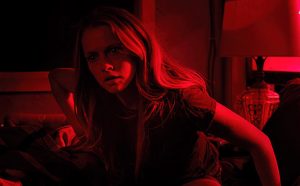
Sandberg is more concerned with the gimmick and thankfully he knows how to frame it. He has a problem in adhering to the ground rules, with Diana’s powers seemingly being made up on the fly. We’re told light hurts her, but she’s able to scurry around in it, opening doors and turning off the lights. She’s even able to travel to Rebecca’s apartment and the textile mill that Paul works at. She can only strike when the lights go out, leading me to believe light doesn’t hurt her in the afterlife, only hindering her. However, the mixture of a blacklight and a flashlight burns her at one point, so that theory goes out the window. This doesn’t even play into her eventual defeat, though credit goes to Sandberg & Heisserer for the ballsy way in which they go about that (even if it could’ve used a bit more build to it).
“Lights Out” is only limited in Sandberg’s mishandling of the rules. He plays it loose with them in order to craft nifty sequences, such as the one in which Rebecca stumbles through rotting mannequins in the basement. Why someone keeps a bunch of rotting mannequins in their basement is anyone’s guess, but it makes for a creepy visual. That is Sandberg’s motif, though, to sacrifice the rules in favor of a creepy visual. None come creepier than Diana’s scraggly body nimbly darting around the perimeters. These moments of terror make us forgive Sandberg’s loose grip, if only slightly.
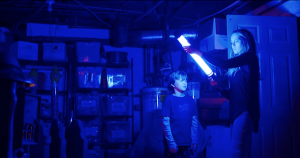
The combination of Sandberg’s keen sense of dread and familial drama aids “Lights Out” in staying afloat. Even Rebecca’s shaky relationship with Bret (Alexander DiPersia), which is engulfed in corny dialogue, is made worthwhile due to its tenderness. It’s all a precursor to the lights flickering, all of which is unsettling.
Final Rating: B-
